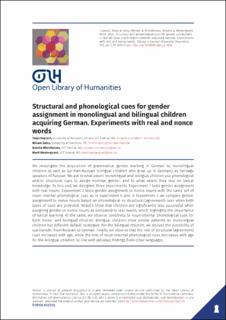| dc.contributor.author | Kupisch, Tanja | |
| dc.contributor.author | Geiß, Miriam | |
| dc.contributor.author | Mitrofanova, Natalia | |
| dc.contributor.author | Westergaard, Marit | |
| dc.date.accessioned | 2022-10-18T13:15:51Z | |
| dc.date.available | 2022-10-18T13:15:51Z | |
| dc.date.created | 2022-01-30T12:53:37Z | |
| dc.date.issued | 2022 | |
| dc.identifier.issn | 2397-1835 | |
| dc.identifier.uri | https://hdl.handle.net/11250/3026715 | |
| dc.description.abstract | We investigate the acquisition of grammatical gender marking in German by monolingual children as well as German-Russian bilingual children who grow up in Germany as heritage speakers of Russian. We ask to what extent monolingual and bilingual children use phonological and/or structural cues to assign nominal gender, and to what extent they rely on lexical knowledge. To this end, we designed three experiments. Experiment 1 tests gender assignment with real nouns; Experiment 2 tests gender assignment to nonce nouns with the same set of noun-internal phonological cues as in Experiment 1, and in Experiment 3 we compare gender assignment to nonce nouns based on phonological vs. structural (agreement) cues when both types of cues are provided. Results show that children are significantly less successful when assigning gender to nonce nouns as compared to real nouns, which highlights the importance of lexical learning. At the same, we observe sensitivity to noun-internal phonological cues for both mono- and bilingual children. Bilingual children show similar patterns as monolingual children but different default strategies. For the bilingual children, we discuss the possibility of cue transfer from Russian to German. Finally, we observe that the role of structural (agreement) cues increases with age, while the role of noun-internal phonological cues decreases with age for the bilingual children, in line with previous findings from other languages. | en_US |
| dc.language.iso | eng | en_US |
| dc.publisher | Open Library of Humanities | en_US |
| dc.rights | Navngivelse 4.0 Internasjonal | * |
| dc.rights.uri | http://creativecommons.org/licenses/by/4.0/deed.no | * |
| dc.title | Structural and phonological cues for gender assignment in monolingual and bilingual children acquiring German. Experiments with real and nonce words | en_US |
| dc.title.alternative | Structural and phonological cues for gender assignment in monolingual and bilingual children acquiring German. Experiments with real and nonce words | en_US |
| dc.type | Peer reviewed | en_US |
| dc.type | Journal article | en_US |
| dc.description.version | publishedVersion | en_US |
| dc.source.journal | Glossa: a journal of general linguistics | en_US |
| dc.identifier.doi | 10.16995/glossa.5696 | |
| dc.identifier.cristin | 1993542 | |
| dc.relation.project | UiT Norges arktiske universitet: 2062165 | en_US |
| dc.relation.project | Norges forskningsråd: 250857 | en_US |
| dc.relation.project | Senter for grunnforskning: 2019/20 MultiGender | en_US |
| cristin.ispublished | true | |
| cristin.fulltext | original | |
| cristin.qualitycode | 2 | |

